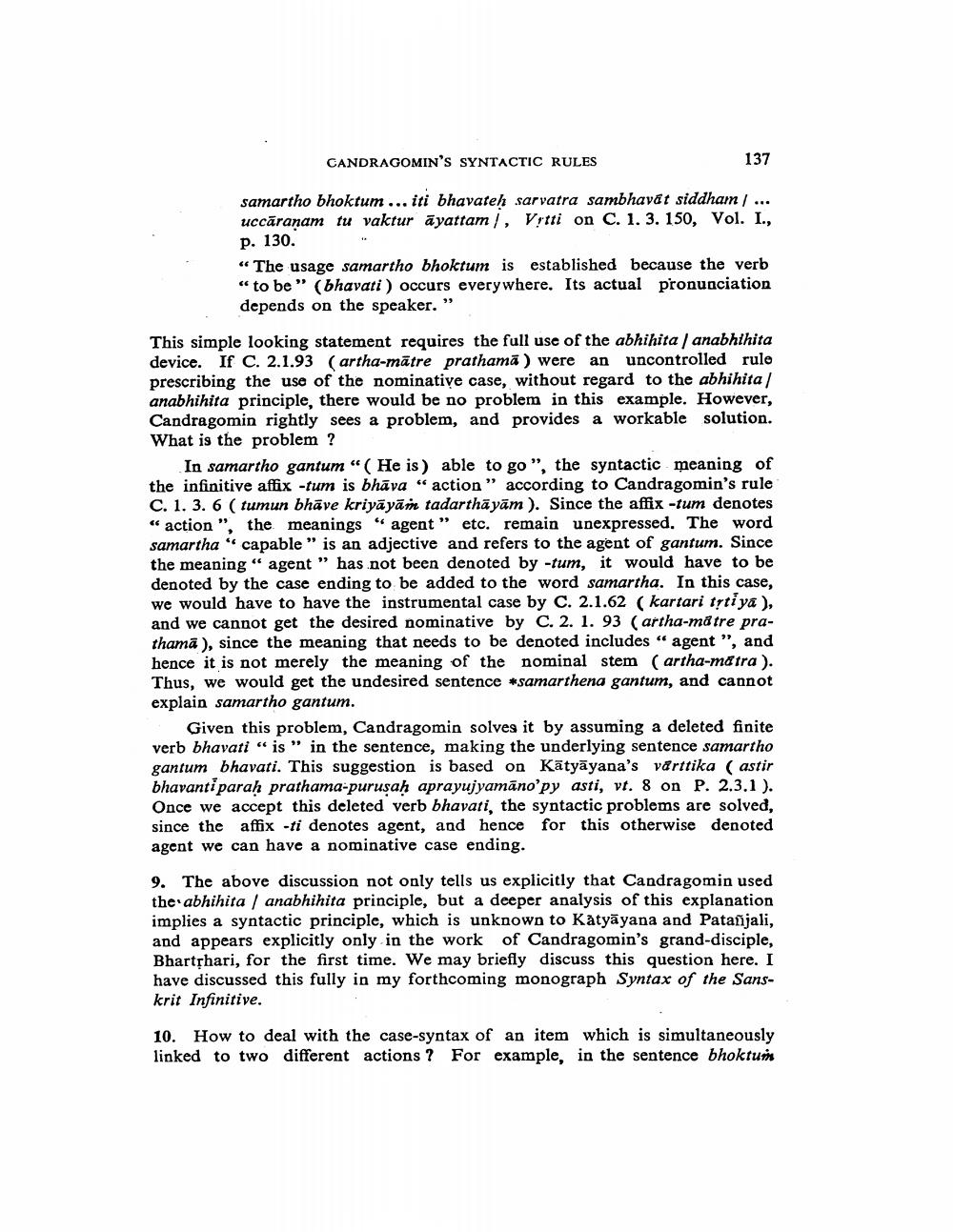Book Title: Candragomins Syntactic Rules Some Misconceptions Author(s): Mahadev Deshpande Publisher: Mahadev Deshpande View full book textPage 5
________________ CANDRAGOMIN'S SYNTACTIC RULES 137 samartho bhoktum ... iti bhavateh sarvatra sambhavat siddham ... uccāranam tu vaktur ayattam), Vrtti on C. 1. 3. 150, Vol. I., p. 130. “The usage samartho bhoktum is established because the verb “to be” (bhavati ) occurs everywhere. Its actual pronunciation depends on the speaker. " This simple looking statement requires the full use of the abhihita / anabhthita device. If c. 2.1.93 (artha-mătre prathamā ) were an uncontrolled rulo prescribing the use of the nominative case, without regard to the abhihita/ anabhihita principle, there would be no problem in this example. However, Candragomin rightly sees a problem, and provides a workable solution. What is the problem? In samartho gantum “ ( He is able to go ", the syntactic meaning of the infinitive affix -tum is bhāva "action” according to Candragomin's rule C. 1. 3. 6 ( tumun bhāve kriyāyāi tadarthāyām). Since the affix -tum denotes " action ", the meanings “ agent” etc. remain unexpressed. The word samartha " capable” is an adjective and refers to the agent of gantum. Since the meaning " agent" has not been denoted by -tum, it would have to be denoted by the case ending to be added to the word samartha. In this case, we would have to have the instrumental case by C. 2.1.62 (kartari trtiya ), and we cannot get the desired nominative by C. 2. 1. 93 (artha-må tre prathama ), since the meaning that needs to be denoted includes “ agent", and hence it is not merely the meaning of the nominal stem (artha-matra ). Thus, we would get the undesired sentence *samarthena gantum, and cannot explain samartho gantum. Given this problem, Candragomin solves it by assuming a deleted finite verb bhavati “is " in the sentence, making the underlying sentence samartho gantum bhavati. This suggestion is based on Katyāyana's varttika ( astir bhavanti parah prathama-purusah aprayujyamáno'py asti, vt. 8 on P. 2.3.1 ). Once we accept this deleted verb bhavati, the syntactic problems are solved, since the affix -ti denotes agent, and hence for this otherwise denoted agent we can have a nominative case ending. 9. The above discussion not only tells us explicitly that Candragomin used the abhihita / anabhihita principle, but a deeper analysis of this explanation implies a syntactic principle, which is unknown to Katyāyana and Patañjali, and appears explicitly only in the work of Candragomin's grand-disciple. BhartȚhari, for the first time. We may briefly discuss this question here. I have discussed this fully in my forthcoming monograph Syntax of the Sanskrit Infinitive. 10. How to deal with the case-syntax of an item which is simultaneously linked to two different actions? For example, in the sentence bhokturPage Navigation
1 ... 3 4 5 6 7 8 9 10 11 12 13
